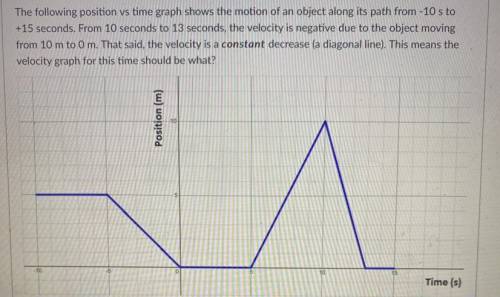
Physics, 07.09.2021 14:00 littylai5524
The following position vs time graph shows the motion of an object along its path from -10 to +15 seconds. From 10 seconds to 13 seconds, the velocity is negative due to the object moving from 10 m to m. That said, the velocity is a constant decrease a diagonal line). This means the velocity graph for this time should be what?
A: flat ( horizontal ) line
B: diagonal line
C: parabola
D: cubic


Answers: 1
Another question on Physics

Physics, 22.06.2019 05:30
Will give brainliest! which statement best describes the difference between strong nuclear forces and weak nuclear forces? weak nuclear forces are involved when certain types of atoms break down. strong nuclear forces are responsible for holding atoms' nucleus together. weak nuclear forces hold bonds between atoms together. strong nuclear forces hold together the nucleus of an atom. strong nuclear bonds prevent atoms from falling apart. weak nuclear bonds prevent compounds from falling apart. strong nuclear forces are involved in breaking electrons from their shells. weak nuclear forces hold protons in the nucleus.
Answers: 3

Physics, 22.06.2019 19:40
12. a body is a particular amount of matter. it can be a solid, liquid or gas. it can be described as existing in a. size and shape. b. motion and force c. time and space. d. location and movement.
Answers: 2

Physics, 23.06.2019 00:20
Ahypothetical metal has an orthorhombic unit cell for which the a, b, and c lattice parameters are 0.413 nm, 0.665 nm, and 0.876 nm, respectively. (a) if there are 8 atoms per unit cell and the atomic packing factor is 0.536, determine the atomic radius (in nm). (b) if the density is 3.99 g/cm3, calculate the metal's atomic weight (in g/mol).
Answers: 3

Physics, 23.06.2019 08:30
[05.02] what is the best explanation of the kinetic molecular theory as it relates to the energy of the molecules in the states of matter? (1 point) the molecules in a gas have greater kinetic energy than those in a liquid, which in turn have greater kinetic energy than the molecules in a solid. kinetic energy cannot be created nor destroyed, and, as a result, all states of matter have the same kinetic energy. the molecules in a gas have greater kinetic energy; therefore, they are more tightly packed than the molecules in either a liquid or a solid. the molecules in gases and liquids, in constant motion, have greater kinetic energy than those in a solid, which do not move or vibrate because their position is fixed.
Answers: 2
You know the right answer?
The following position vs time graph shows the motion of an object along its path from -10 to +15 se...
Questions


Physics, 08.12.2021 17:30






Mathematics, 08.12.2021 17:30


Mathematics, 08.12.2021 17:30

Mathematics, 08.12.2021 17:30

Mathematics, 08.12.2021 17:30

Mathematics, 08.12.2021 17:30

English, 08.12.2021 17:30

Business, 08.12.2021 17:30



History, 08.12.2021 17:30




